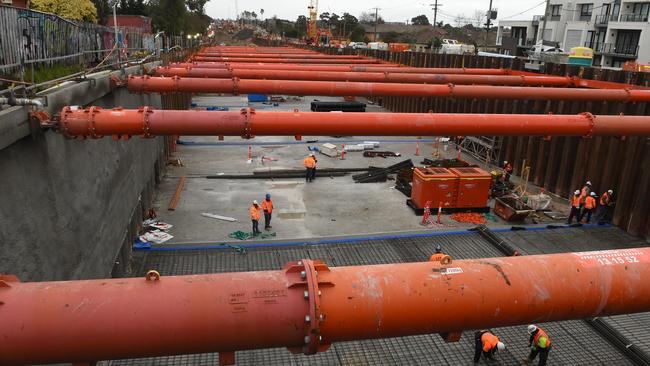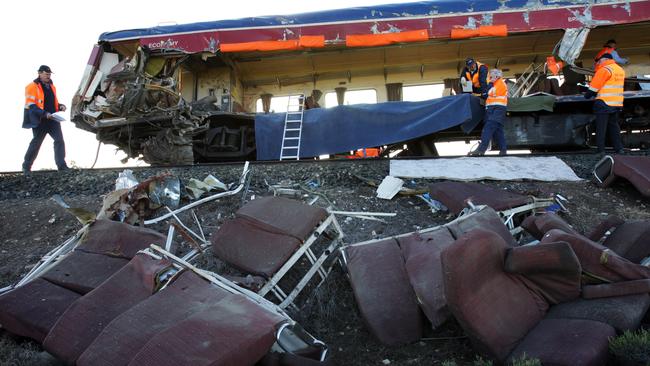Safety of level crossings in spotlight following the death of two after their car collided with a train
MOTORISTS use them every day but following the tragic death of two women, it has be to asked, is there a safe level crossing?
AN ELDERLY motorist and her passenger who died on Wednesday when a train slammed into their car on a level crossing, “didn’t stand a chance,” says a transport safety expert.
The expert also says there will never be a way to make the crossings 100 per cent safe.
It’s the latest level crossing crisis for Victoria with faults in some boom gates made public in January.
The Victorian Government is currently spending billions of dollars to remove 50 of Melbourne’s 180 level crossings.
But it has emerged that the crossing where the tragedy occurred is not on that list despite locals saying it suffers from regular bumper-to-bumper traffic.
The two woman, aged 71 and 73, both from Camberwell in Melbourne’s east, were killed when their Hyundai became trapped in the middle of the crossing on Union Road in Surrey Hills just before 4pm on Wednesday.
An express train slammed into the car, ripping it in two and wedging it beneath the carriage wheels, dragging the vehicle 150 metres before it came to a rest at Surrey Hills station.
Metro Trains chief engineer Phil Ellingworth said authorities would investigate whether signalling issues had been a factor.
Victorian Premier Daniel Andrews said his “thoughts and best wishes,” were with the victims and their families.
“It’s a horrific incident and one which reminds all Victorians of the need to remove the level crossings. These are relics of the past and they need to go,” Mr Andrews said.

DRIVER PANIC
Police said the car was on the centre of the crossing when the boom gates came down.
“The driver has been unsure of what to do from there and as a result the train travelling through, an express train, has then collided into the motor vehicle,” acting sergeant Glen Whitehead said.
Road safety expert at Queensland University of Technology (QUT), Dr Gregoire Larue, told news.com.au he suspected there were two explanations for the incident.
“Once the boom gate started to go down, the driver panicked and didn’t know what to,” Dr Larue said.
“But also some of the level crossing around Melbourne are very congested so maybe there was no opportunity to get out of the level crossing because it was blocked by other vehicles.”
In the latter nightmare scenario, the driver would be unable to move backwards due to the queue of vehicles behind or clear the crossing by going forward because of traffic congestion ahead.
The Surrey Hills crossing is just 150 metres north of a busy intersection with Canterbury Road, one of the major roads to Melbourne’s eastern suburbs.
Dr Larue said there were particular problems with Melbourne’s crossings due to the sheer number of trains and cars having to negotiate for space.
“Level crossings in peak hours are closed for a very, very long time, they can be opened and closed again for the next train just a minute later so they doesn’t give enough time to remove all the traffic,” he said.

DIDN’T STAND A CHANCE
“People take risks because they know they can be stuck for a long time so there might be a temptation to go soon as possible.
“Trains are very heavy and what people don’t realise is the trains have no chance to stop in time even if the brakes are applied.
“This train was never going to stop in time to avoid the collision. Basically, they didn’t stand a chance.”
Dr Larue said it was an ongoing problem with level crossings with the number of injuries and fatalities not going down.
Between 2000 and 2012, 601 vehicles collided with trains on level crossings, according to the Australia Transport Safety Bureau. Of that number 192 were in Victoria, 157 in Queensland and 95 in NSW.
Almost 140 people died on Victoria’s crossings during the same decade accounting for 55 per cent of all crossing deaths in Australia.
In terms of collisions with pedestrians, Victoria again led with 51 people hit compared to 10 in Queensland and just five in NSW.
One of Australia’s worst level crossing accidents happened in 2007, again in Victoria, when a V/Line train ploughed into a semi-trailer near Kerang, killing 11 people.
Just last month, a 28-year-old man died when his car collided with a train in Bairnsdale, in the state’s east.
One of the reasons behind Victoria’s shocking record is the sheer number of crossings in urban areas. There are 180 in Melbourne compare to less than 10 in Sydney, the majority of which are concentrated on a single line in the city’s less populated north west.
Across Australia, there are about 20,000 level crossings in place.
Research conducted in 2002 by QUT’s Angela Wallace found there were three groups of drivers most at risk from injury and death on level crossings.
Younger drivers were risk takers who often tried to “beat the gates”. Heavy vehicle drivers sometimes underestimated the size of their vehicles while older drivers had “errors of judgment” when it came to the crossings.
In the report, Ms Wallace talked to train drivers who noted that it was a “common occurrence for motorists to drive through a crossing when the lights are flashing both before and after the booms were activated”.

NO HOPE
Dr Larue said another issue at the Surrey Hills crossing may have been that both trains that stop at the station and express trains came through.
“(Motorists) familiar with the crossing may think they have plenty of time but there may be lots of difference in time between trains reaching the crossing — some might take two minutes, some only 20 seconds.”
For the two elderly passengers, by the time they knew something was wrong the fast train may have been only seconds away.
Some crossings, said Dr Larue, had sensors in the tracks to detect vehicles. But even that might not be enough time to warn a driver and bring the train to a halt.
He said there would never be a fully safe level crossing.
“Removing the level crossing is the best thing to do so you remove that interaction between trains and cars, but from the numbers (being removed) it’s not going to solve the problem entirely,” he said.
“(Car) drivers have to realise how dangerous it is and they should never enter a level crossing if they are not sure they can get through.”
Rail Tram and Bus Union Locomotive Division divisional secretary Marc Marotta said a sharp left-hand curve on the track meant the train driver wouldn’t have seen the car until it was on top of it.
“A 300-plus tonne train doing 80km/h — you can’t stop. You have no hope.”
Police are urging anyone who may have witnessed the collision, or who may have information to contact Crime Stoppers on 1800 333 000.
benedict.brook@news.com.au




